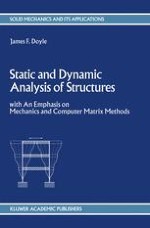This book is concerned with the static and dynamic analysis of structures. Specifi cally, it uses the stiffness formulated matrix methods for use on computers to tackle some of the fundamental problems facing engineers in structural mechanics. This is done by covering the Mechanics of Structures, its rephrasing in terms of the Matrix Methods, and then their Computational implementation, all within a cohesivesetting. Although this book is designed primarily as a text for use at the upper-undergraduate and beginning graduate level, many practicing structural engineers will find it useful as a reference and self-study guide. Several dozen books on structural mechanics and as many on matrix methods are currently available. A natural question to ask is why another text? An odd devel opment has occurred in engineering in recent years that can serve as a backdrop to why this book was written. With the widespread availability and use of comput ers, today's engineers have on their desk tops an analysis capability undreamt of by previous generations. However, the ever increasing quality and range of capabilities of commercially available software packages has divided the engineering profession into two groups: a small group of specialist program writers that know the ins and outs of the coding, algorithms, and solution strategies; and a much larger group of practicing engineers who use the programs. It is possible for this latter group to use this enormous power without really knowing anything of its source.
